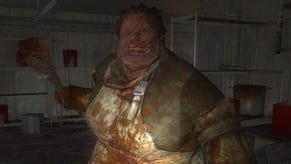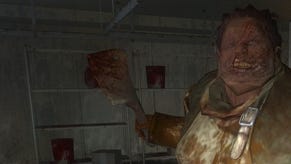Condemned: Criminal Origins
That's 'origins', not 'oranges', Tom.
You know a game's doing something right when it makes you scared of your own footsteps.
Creeping through the perennial inky gloom, armed with only a rusty pipe, a failing torch and some palpitating hallucinations, you know only one thing: they're out there somewhere.
Where and when they come is moot. With that seed of certain uncertainty firmly planted in your head, Condemned keeps you on tenterhooks for hours on end as you inch your way closer to the source of all this unpleasant madness. With its perpetual grip on suspense giving way to increasingly frantic close encounters, it's an ebb and flow that drags you through - probably by a rusty, disease-ridden hook.
Probably the first thing that strikes you about Condemned is what a marked change of pace it is next to all the other 360 launch titles. While every other title we've played lately wants to prove how fast and furious it can be, Condemned is deliciously laid-back by comparison. It's the first game of this new generation to invite gamers to soak up their surroundings, to poke around, to observe and listen carefully. While all the finely textured environments normally pass you by in a blur, Monolith gives you an appreciable reason to stop and admire the decaying, festering hell-holes you frequent. For this is where the seedy underbelly of society resides.
Watching the detectives
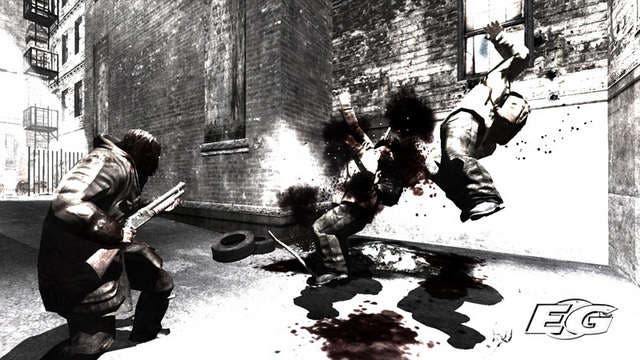
In common with other recent starlets of the burgeoning first-person adventure scene (Call of Cthulhu and Chronicles of Riddick, most notably), Condemned likes to build up the narrative journey and intersperse it with a more measured approach to the action. On the one hand it's this slow-burn investigative first-person adventure that tasks you, Ethan Thomas, with looking for clues and tracking the whereabouts of serial killers, and on the other it's a panic-stricken fight for survival against the vagrant population of the world.
To begin with, you're just another undervalued FBI agent scouting around a dark, dank and low-down building on the trail of a serial killer. But quickly the tables are turned, your gun is stolen and suddenly you find yourself blamed for the murder of two fellow officers. Realising that no-one will believe what really happened, you take the law into your own hands and follow the trail of evidence to the source of this thickening plot.
Right from the opening minutes, the template for the game's design is firmly established. Your first priority is to track down any evidence that's lying around, and thanks to Thomas' hi-tech equipment, you're able to gather all manner of important trace elements that would otherwise be invisible to the naked eye. Justified by Thomas' investigative instincts he'll always know when evidence is nearby (which is useful, obviously, or else the game would be pretty torturous). As such, this handy little ability manifests in the game prompting you to hit X to use the appropriate Forensic tool when necessary, and again once you're in the right area to collect evidence samples. Available automagically (with no bothersome inventory selection procedure to wade through), you'll get to wave a UV Light (to detect blood traces), a Laser Light (for finger prints, fluids, etc), a Gas Spectrometer (to find the source of an odour), as well as Collection Tools comprised of a Sampler (to determine the chemical make up), 3D Scanner (for fingerprints, wounds, etc) and the all-important Digital Camera. Presumably Thomas has a sizeable backpack for all this gear - he's part Sherlock Holmes, part Inspector Gadget with all this lot to lug around.
Surfer Rosa
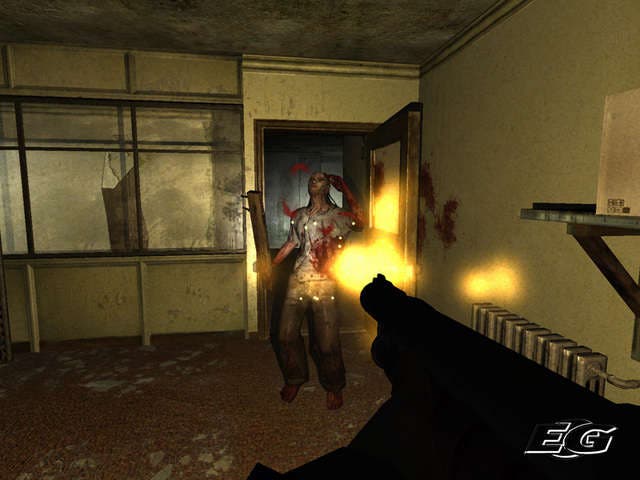
Once you've gone through this little rigmarole, you - conveniently - still have a means to transmit the results back to the forensic lab, thanks to the trusting nature of Rosa, the sole FBI agent to believe your innocence. Now and then she'll chime in on the mobile phone with advice and analysis that helps direct you to the next location, and also serves as a crucial narrative device in an otherwise quite lonely game.
In between all of this forensic foreplay, the strange, inexplicably murderous vagrant population of all these deserted, ramshackle buildings will do their best to snuff out your vital signs. We never really sussed out why they felt so compelled to attack this blameless agent, but given their determination to use extreme force against you, you're left with no choice but to meet fire with fire. To begin with, that's a pretty perfunctory task, as you're armed with a pistol and they're not. But once the tables are turned and you're stripped of your (pretty paltry) arsenal, the only thing left to do is find some sort of melee weapon. Whatever, wherever.
In somewhat contrived circumstances, there are dozens of things you can wield: pipes, sticks, crowbars, axes, bits of wood, shovels, you name it. Some are easier to wave around than others, some do more damage than others, some reach further than others and some block better. Faced with an aggressor, your only thoughts are to take them down as quickly as possible, but it's never as easy as that. Unarmed opponents quickly find weapons of their own, and often hide in the shadows behind cover, waiting to blat you over the head when they get the chance. Move within range, and these grunting, roaring aggressors swing for all they're worth, and move in for the kill. Hitting the left shoulder button blocks momentarily, while right shoulder button performs an attack, and a click down on the right thumbstick delivers a swift kick in the nadgers if you can line it up right. With a mixture of kicks, blocks and counter attacks, you can see off these scumbags with the minimum of fuss, but mess up the timing and you'll be the one on the end of a crunching blow - and no-one needs a Fire Axe 'round the face.
Razzle dazzle

As first-person melee combat goes, it's handled far better than the occasionally ludicrous Riddick 'punch-blizzard', and really packs a wince-inducing force into it, complete with hideous sound effects and dazed visual effects. Not nice. And once the game starts upping the enemy count, it becomes hugely challenging and tactical, too. Also equipped with a Tazer, you're able to stun enemies into submission for a few seconds by tapping the secondary left trigger. Head swimming, you're then able to finish them off in relatively risk-free fashion - normally with a quick kick where it hurts. Now and then, you're even given the chance to pull off a grisly finishing move, giving you a chance to exact retribution in close-up, neck-snapping, face-ramming fashion for full-on gratuitous effect. It stops short of being Manhunt, but it's best played before a meal.
As you start chipping away at each chapter, the enemies definitely get a lot smarter, often working as a pack to flush you out. The library level, in particular, really shows off some excellent enemy AI, with their ability to find and change cover, force you out of hiding (and into the line of their fire), retreat when wounded, and occasionally behave like they value their own life (not something you see very often in videogames, it has to be said). Of course, most of them still want to charge suicidally at you, but there are moments when you really do stop and have to think of a way to deal with an angry, organised mob.
But it's not all about iron bars and axes, with fleeting (and hugely welcome) appearances of pistols, shotguns, and eventually rifles and machine guns. Being such rare commodities, the firearms come in extremely handy on occasions where you're seriously outnumbered and outgunned. Being able to finish off a rapidly approaching foe with a head shot and then turn around and do the same to his mate is hugely satisfying, not to mention really bloody scary. But, given the paucity of ammo (there are no ammo pick ups at all, and you can only carry one weapon of any kind at one time), you'll regularly find yourself forced to resort to wielding it as a melee weapon, which is hardly the most effective thing to do. At times like this, it's one of the most satisfying game mechanics ever to Tazer them, whip their gun out of their hands, blast their face off with it and kick them in the cobblers for good measure. No-one said it was a nice game.
Lock up your Jaffas
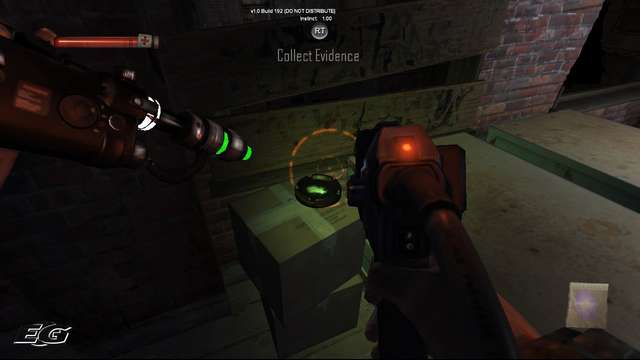
So, while Condemned is never the most varied or challenging game in terms of its consistent reliance on simple, slow-paced puzzling in the dark and reliance on guttural combat to fill in the gaps, the core mechanics are always just about entertaining enough to keep you immersed and entertained right throughout the 12 or so hours it'll take you to plough through.
A crucial part of the enjoyment value you'll get out of Condemned will rely on whether you've got the right kit to get the most out of it - and this is something, we suspect, that will apply to a lot of next-gen titles. Take the audio, for example. If you've been holding off on getting some sort of surround sound set-up, then now's the time to justify it, because Monolith has created an astonishing example of how to scare gamers witless, just by playing on our fear of things that go bump in the night. Wandering around the darkened corridors with just a torch for illumination, there are innumerable opportunities for enemies to leap out at you, or for a faraway object to rattle inexplicably. Half the time there's no-one there; it's just you clattering into something, or some harmless rodent slithering off into the gloom. But yet, you don’t want to take any chances, so you end up creeping around stealthily in the knowledge that there could be something out there. For that reason alone, Condemned scores an extra mark, because if there's another game that delivers that same sense of being scared of your own shadow, then we've not played it. It's so invisible and so subtle, yet so important when you add it to the mix.
The visuals, too, are an excellent example of why high definition is so important to delivering those extra immersive elements that suspend your disbelief a little bit more. Right from the beginning it's evident that Monolith has gone to great lengths to create rich, atmospheric environments that literally ooze with detail. But it's not just the intricate texturing, the subtle lighting, the gruesome character detail, their impressive animation or the omnipresent particle effects. Everything just fits, everything has a physical property, and characters interact with the environment as they should. There's a real solidity to the world that means you spend less time grimacing about texture seams and objects poking through solid walls, and more time just lost in the moment. Sure, you can laugh like a baboon for a few minutes when you catch sight of your shadow doing a two-frame high kick, but on the whole it's a game that was made for big screen, high definition viewing. Few games have looked so gruesome, dirty, and unpleasant. You'd swear on occasion that you can imagine the smell of the place.
Get the balance right
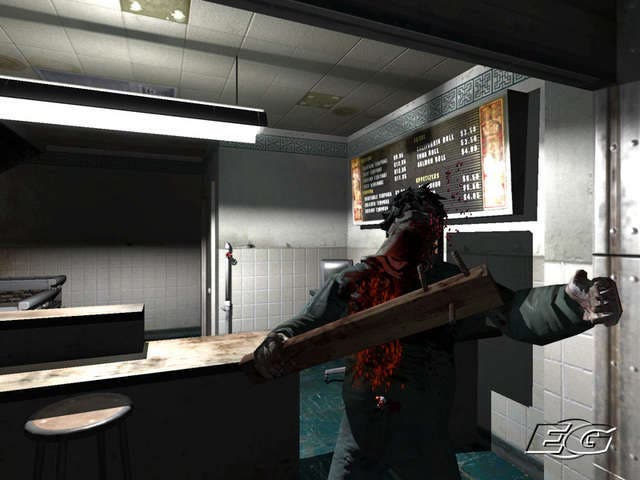
Still, even with that all taken into account, even with all that terrified enjoyment to be had, it's all rather too simplistic for its own good. Similarly unhinged games like Silent Hill went to the next level by having superb puzzles, and a more coherent sense of place (as opposed to a set of levels you never return to). Condemned's puzzles are consistently insultingly easy, and as such the entire game requires little to no intelligence to suss out. While we appreciate the need to strike a good balance between offering a challenge and making the game consistently fun, all Condemned asks of a player is whether they can find an axe to chop down a door, or a spade to shove into some electrics; and not only that, it then tells the player to go off and find one, limiting the feeling of achievement even more.
The whole forensic instincts thing is a bit tragic, too, basically giving the player no chance to act as an investigator at any point. To simply reduce your role in the game to a mindless button-presser and fetcher-carrier is actually quite alienating at this point. It's as if 30-odd years of game development has decided that we have more fun if we're stretched less which is faintly bizarre. Our overriding problem (if there is one) is that Condemned is dumbed down deliberately, yet slaps an 18 certificate on the box. Monolith, if you want to make an adult game, then don't treat us like imbeciles. We want tasks that stretch us, that give us a sense of achievement. What we don't want is to have to march off and get a fire axe a dozen times, and be patted on the back for being anal enough to find all the dead birds and metal objects hidden around. That's not an achievement to justify a great GamerScore on your Live rank, that's just a sign of dogged 'click on everything' persistence.
Having created this wonderfully ambient platform to build an amazing investigative horror epic on, Monolith and Jason Hall settled for making something that's entertaining on a basic, primal level, but then failed to capitalise on that. The way was clear to make Condemned something truly outstanding, but in the end its place in gaming history will go down as merely 'a pretty good horror-adventure' - which is a great shame. In terms of getting an original game to go with your 360, this is definitely recommended on that level, but in the broader context it's a sign that next generation gaming may offer a wonderful audio visual experience, but it needs to be a tad more ambitious in the game design stakes.

